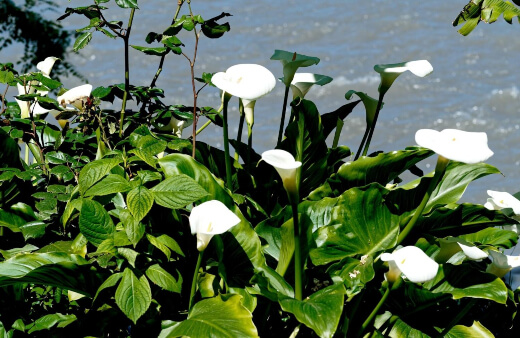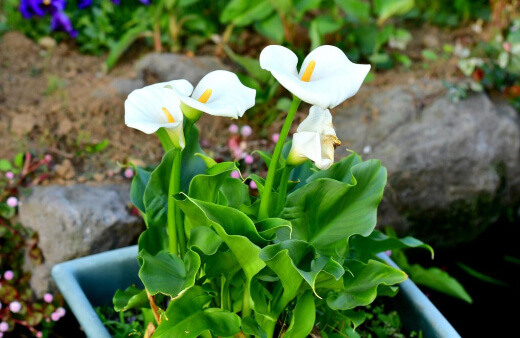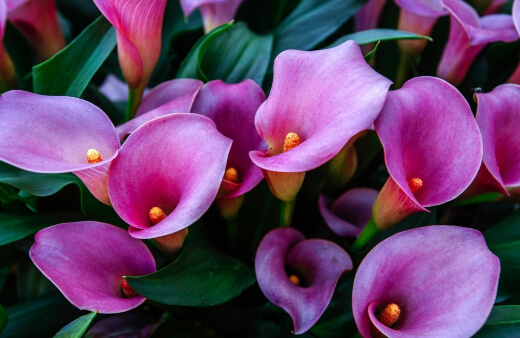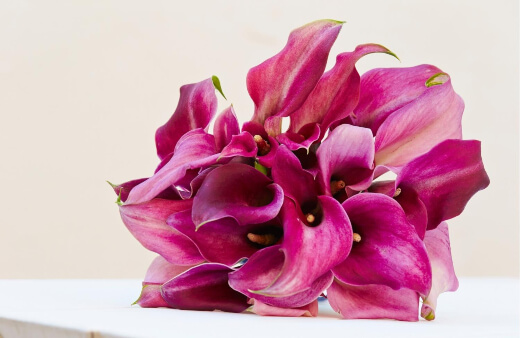The Calla Lily is known for having quite the social calendar, popping up at weddings and funerals all over the world. The white calla lily is the most familiar sight but many hybrids exist in a rich variety of colours.
Shades of yellow, red, maroon and peach make this delightful bloom popular for garden growing but also as a cut flower. Calla lily is elegant and always a lady.
In this article, learn about how to plant and care for your own calla lily, what to look out for in terms of plant health, and of course, some interesting frequently asked questions.
More...
Calla Lily Plant Details

Zantedeschia aethiopica is more commonly known as the calla lily and arum lily. The name of the genus is a tribute to Giovanni Zantedeschi, an Italian physician and botanist.
There are six different species of this flower. It’s important to know that calla lilies are not true lilies - they belong to the Arum family of plants and are native to southern Africa.
Calla lilies are versatile when it comes to climate. In warm climates, they grow well in full sun or partial shade. In cooler areas they grow best in full sun.
If you stay in a colder area, the calla lilies can either be grown as annuals or you can dig it up in Autumn to store indoors, replanting it the following spring.
Varieties of Calla Lilies
No matter what your preferred colour scheme, there are so many different calla lily varieties to choose from. Let’s take a closer look at some of the popular ones below:
- Zantedeschia ‘Acapulco Gold’ – the name itself makes you think of sunny yellow and that’s exactly what it is. ‘Acapulco Gold’ produces large, bright yellow flowers.
- Zantedeschia ‘NightLife’ and Zantedeschia ‘Night Cap’ – if you enjoy a rich colour, these varieties both boast a deep shade of purple. ‘NightLife’ produces a bigger and darker flower that has more of a blue tone, while ‘Night Cap’ has a smaller flower in a more reddish purple.
- Zantedeschia ‘California Ice Dancer’ – a whimsical image comes to mind with this variety of calla lily, which produces large, creamy white flowers on stalks that grow up to 0.5 metres tall. The leaves are a darker green than the other varieties.
- Zantedeschia ‘California Red’ – this is the perfect shade of deep reddish pink.
- Zantedeschia ‘Pink Melody’ – imagine a flower that goes from green to white to pink as it extends from the plant. Like the ‘California Ice Dancer”, it is also a tall calla lily, reaching 0.5 metres in height.
- Zantedeschia ‘Crystal Blush’ – this is very similar to ‘Pink Melody,’ but is whiter with just a blush of pink on the tip of the petals.
- Zantedeschia ‘Fire Dancer’ – you could call this one the show off of the calla lilies, with its large flowers and shades of gold and red.
Special features of the Calla Lily
Calla lilies are very toxic and should not be eaten. The Zantedeschia species are poisonous because of the presence of calcium oxalate. Although it can’t be enjoyed as a food, the underground stem of calla lilies were actually used as a medical treatment for dressing wounds in South Africa.
The calla lily is a favourite choice for events, both happy and sad, because they are elegant and are symbolic of purity. The flowers are often used in bridal bouquets and funeral arrangements.
How to Grow Calla Lily

The beautiful Calla Lily flowers grow from a rhizome, also called a creeping rootstalk. It has huge green leaves covered with lighter spots and colourful flowers from pale pink to deep purple that sit on top of trumpet-shaped stems.
Once the flowers wither, they leave behind a pod-like capsule full of flower seeds. Zantedeschia aethiopica can grow to waist height. They need plenty of water and a high phosphorus fertiliser. Fertilising calla lily plants improves its health but also creates more and bigger flowers.
The Ideal Growing Environment of the Calla Lily
Calla lilies are usually found growing happily in moist soil along riverbanks, streams or ponds making it a perfect addition to your garden pond. You might even find them around the edge of a water garden.
It’s safe to call them low-maintenance plants, as long as you get their water balance right – that means no extremes like excessively dry or soggy, poorly drained soil.


Get Your Free Guide:
Master Growing Australian Natives eBook
A Must Have Complete Guide for Every Australian Garden
Get Your Free Guide:
Master Growing Australian Natives eBook
A Must Have Complete Guide for Every Australian Garden
How to Grow a Calla Lily from seeds
Aside from purchasing seeds, you could also harvest mature seed pods from an existing plant. You need to wait until the seed pods are completely dry before removing them from the plant.
If you plan to grow calla lilies from seed, you will need some patience. It can take up to three years for calla lilies planted from seed to bloom. That’s quite an investment before you reap the beautiful benefits of this bloom.
Preparing the seed
Calla lily seeds need to be pre-grown for the whole process to succeed. You’ll start by spreading the seeds out on a damp paper towel and covering them.
Place the paper towel somewhere cool and check the seeds a few days later for growth. You can throw away any that look like they’re not growing.
Next, you need to put a high-quality soilless medium in a well-draining pot together with the seeds that have started growing. Soilless media can be anything from sand, gravel and pebbles to sawdust, straw and sponges.
Planting Calla lily Seed
Plant two seeds per pot just underneath the soil. Keep the soil moist and keep an eye out for growth. After a week you can again throw away any seeds that haven’t grown.
Keep an eye on the plants for another few weeks and remove the weaker shoot from each pot so that the stronger one can flourish. When the calla lily has been growing for a while, you can transplant it into a bigger pot or outside.
Before you do this, wash the plant roots to remove bacteria, and water the transplanted calla lilies often until it establishes itself.
Propagating Calla Lily from Bulbs

You need to separate the rhizome or bulb from the rest of the root mass. If in doubt, cut the root which is connected to a separate stem.
Use a well-drained soil mix and lay the bulb face with ‘eyes’ on top and the side without ‘eyes’, placed on the bottom. Only the eyes should be showing and every other part of the bulb needs to be covered with soil.
The bulb needs plenty of water so keep watering until it drains out of the pot. Plant Arum lily deeply, around 10 centimetres and space each bulb 30 centimetres apart (if they’re going in the garden).
Start the bulbs off indoors in late winter and transplant them in spring when the likelihood of frosty temperatures has passed. Apply a bulb fertiliser every month while the calla lilies are actively growing.
For more advice on how to successfully take a cutting, have a look at our step by step guide.
Caring for Calla Lily
Resting period after flowering
Just remember Zantedeschia aethiopica generally needs a rest period after flowering. It’s hard work creating such beautiful blooms! You can let the leaves die back and leave the plant to rest for 2 to 3 months. Then start watering again to encourage new growth.
Sunlight
Calla lilies grow well in temperate to warm climates. They are also great as indoor plants. (See more indoor plants you can grow here) They are not temperamental plants, adapting well to full sun or partial shade.
Soil and fertiliser
We suggest adding a well-rotted compost or cow manure into the soil to start the plant feeding process. Twice a week, you could add a diluted fish emulsion which also promotes growth.
Calla lilies also need their calcium. Natural sources of calcium include bone meal and eggshells. You can add gypsum or lime to the soil before planting calla lilies but this should be done at least six months prior so you’ll need to plan ahead.
Use good compost which has a balance of nitrogen and carbon. This is a natural and slow release product which will feed the bulbs for a year as it gradually works into the soil.

Watering Arum Lily
Your calla lilies watering needs depend on whether they are grown in the garden or in containers. Your current growing conditions, like the amount of light or soil type, should be factored in as well.
Water outdoor calla lilies regularly, providing sufficient water to keep the soil evenly moist. If the soil doesn’t drain well, improve it by adding compost or other organic materials.
Potted calla lilies should also be watered frequently to keep the potting mix evenly moist but not soggy. Use a well-draining potting mix - Calla lilies like moisture but not poorly drained soil.
A soilless mix with materials like mulch, or sand, can provide proper drainage.
Annual Check Up
Your calla lilies will need an annual feeding – best to use an organic product. This will deliver nutrients to the plant at a slow rate so it can easily uptake them.
Putting bone meal around the root zone adds phosphorus which is great for blooming. The Yates Fertiliser Buying Guide has some helpful reviews when shopping for the right plant food.
Common Arum Lily Problems, Diseases, and Tips
Arum lily problems arise when the plant is over or under watered. You’ll notice that the calla lily flower starts to droop. This could be caused by excess nitrogen or a fungal rot disease.
If your Arum lily has leaves that are a deep and rich green, you know it’s happy and healthy. If you notice yellowing leaves, something could be wrong with your plant.
The first place to investigate is beneath the soil. Yellow leaves are a sign of problems with the root of the plant. There are a couple of different things that could cause this. The yellowing of leaves is also known as chlorosis.
Sometimes this is caused by a nutrient shortage in the soil – the common deficiencies are nitrogen, iron, zinc or another trace element. Either the soil is deficient in the trace element, or the roots aren’t able to absorb the nutrients.
Another common reason for the usual bright green leaves of the Zantedeschia aethiopica turning a sad yellow, is root rot. These plants don’t like their roots constantly soaked in water. Too much water will cause the roots to begin rotting and you’ll see the leaves wilting.
If your calla lily is growing in a pot, make sure it’s unglazed so any excess moisture can evaporate. If rot has set in you will need to throw away the bulb and start again.
Cool and wet conditions can cause the formation of fungal spores in the soil that attack the bulb and stems of the plant. Once it hits the stems they become weak.
One of the best cures is to replace the soil if possible - dig up the plant and transfer it to a spot with well-drained soil. If it’s a raised bed, even better.
Calla Lily Frequently Asked Questions

Why is the flower called the calla lily?
The flower was named after the Greek word for beautiful, which is calla.
Native to southern Africa, where else has the calla lily naturalised?
You will find it in Kenya, Malawi, Tanzania, Zambia, coastal California and Australia, particularly in Western Australia, although here it is considered to be a toxic weed and pest.
What does the calla lily symbolise?
The most common meaning for calla lilies is purity, holiness, and faithfulness.
When are calla lilies in full bloom?
The blooming time of calla lilies is late spring.
How poisonous is the calla lily?
These plants should be kept out of reach of pets and small children. All parts of the plant contain toxic oxalic acid. This can cause nausea, vomiting and swelling of the tongue when ingested.
How did calla lilies become so popular?
Calla lilies first appeared in the public eye in the Royal Garden of Paris painting.

Bring a Touch of Sophistication to Your Garden with Calla Lilies
Zantedeschia aethiopica lives up to its name of defining beauty and being a charming and flirty garden addition, even though some call it a weed! The calla lily has earned its place at special events because each shade of flower carries a meaning. Whatever the occasion, happy or sad, there seems to be a variety of calla lily to suit.
It grows well next to other plants and whether potted, in a garden bed, or just casually adorning a vase, the Zantedeschia aethiopica, or calla lily if you prefer, gets our thumbs up!
Published on February 19, 2022 by Maisie Blevins
Last Updated on September 20, 2025





Living in Sydney I can often get very hot temperatures between 29 – 34 degrees and intense sun heat. Currently my Calla lily is exposed to that for around 6 hours during those days. Is this too much for the lily to take? Should I move it to a sunny yet cooler spot?
Hi there Lachlan,
So, normally Calla Lilies love the full sun where 6 hours per day can be optimal for their health. However, this is recommended more for areas that experience a cooler summer.
As you’ve mentioned, you are experiencing very hot temperatures and intense sun for most of the day. This could be too much for your Calla Lily to handle.
In hotter climates, partial shade can be better for Calla Lilies and can also be necessary for their survival. The blooms may not be as impressive but the plant could thrive better with a bit more shade and less direct sunlight in your area.
If you do decide to move your plant, a little extra water can also help perk it up in a couple of days.
Kind regards,
Gary Clarke